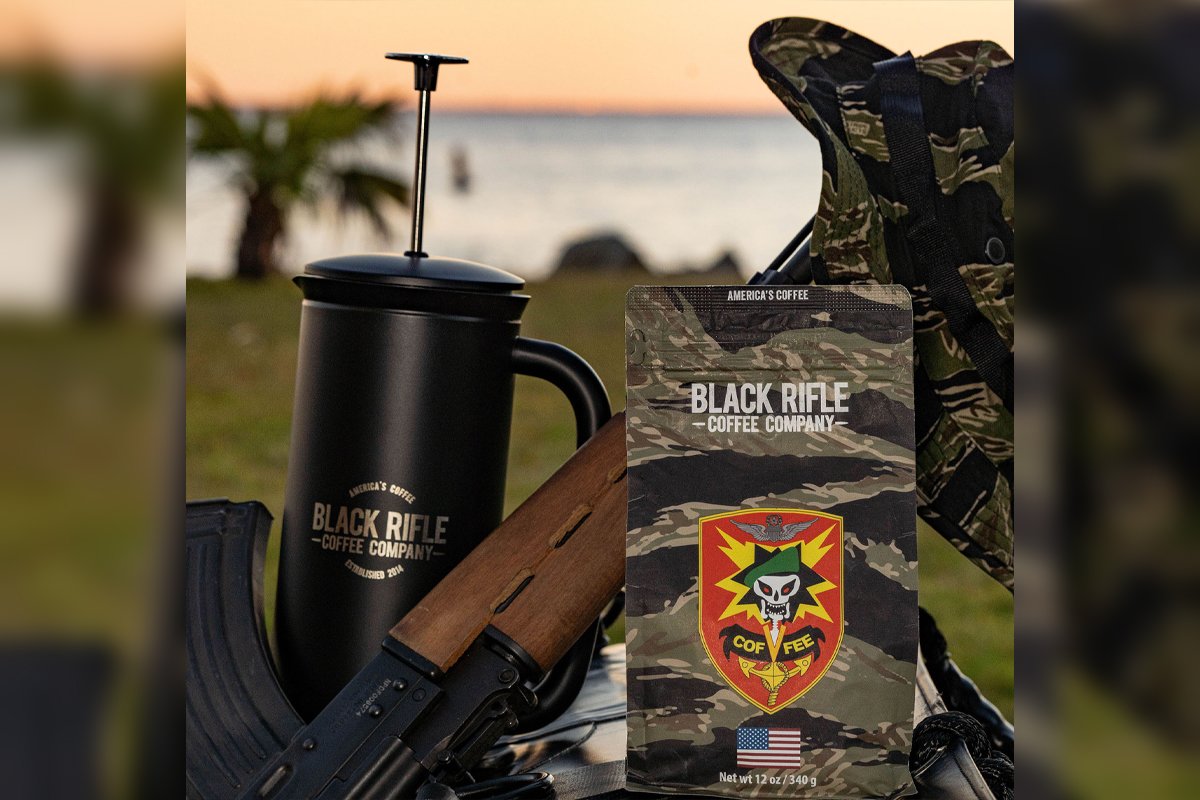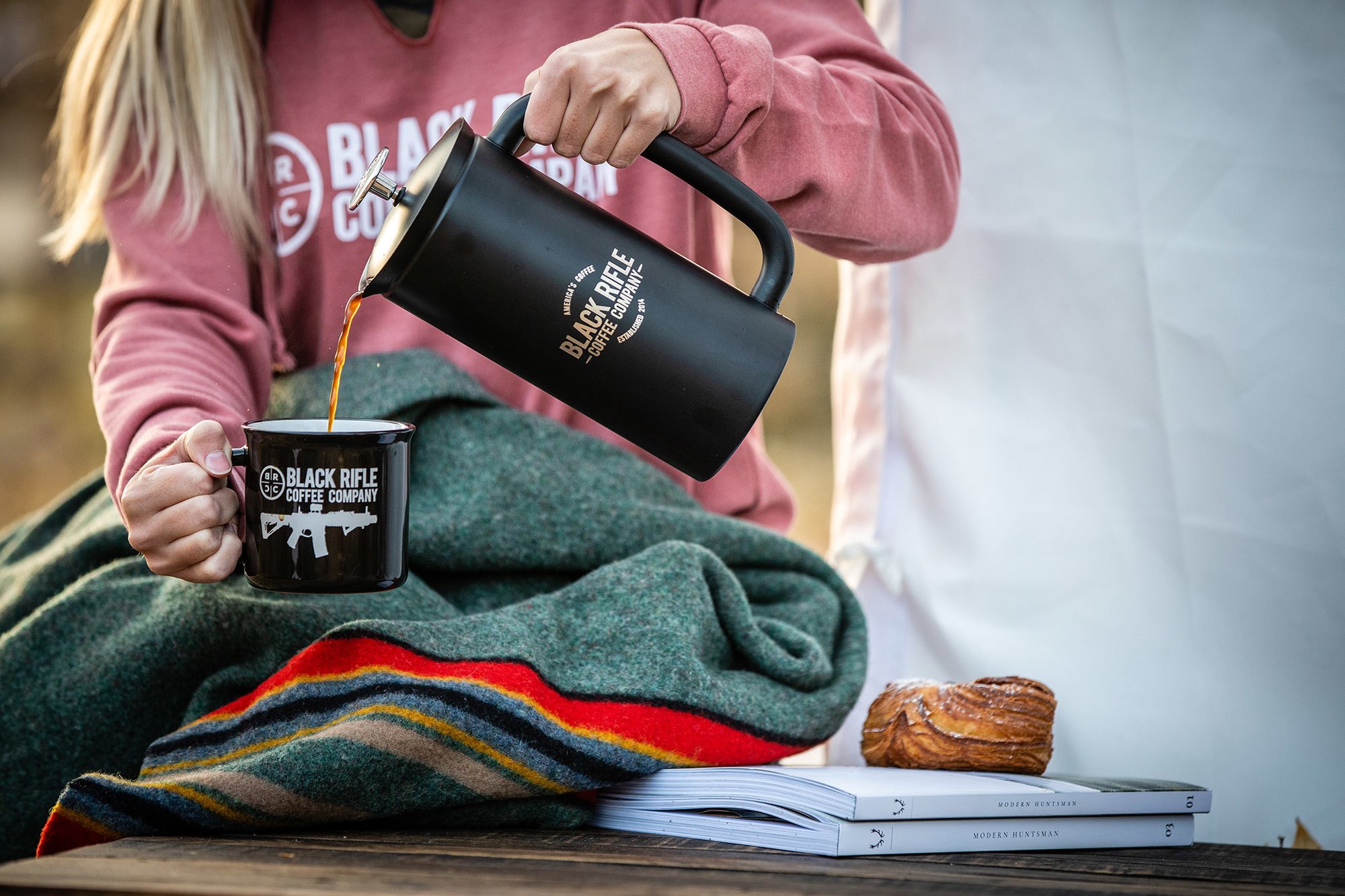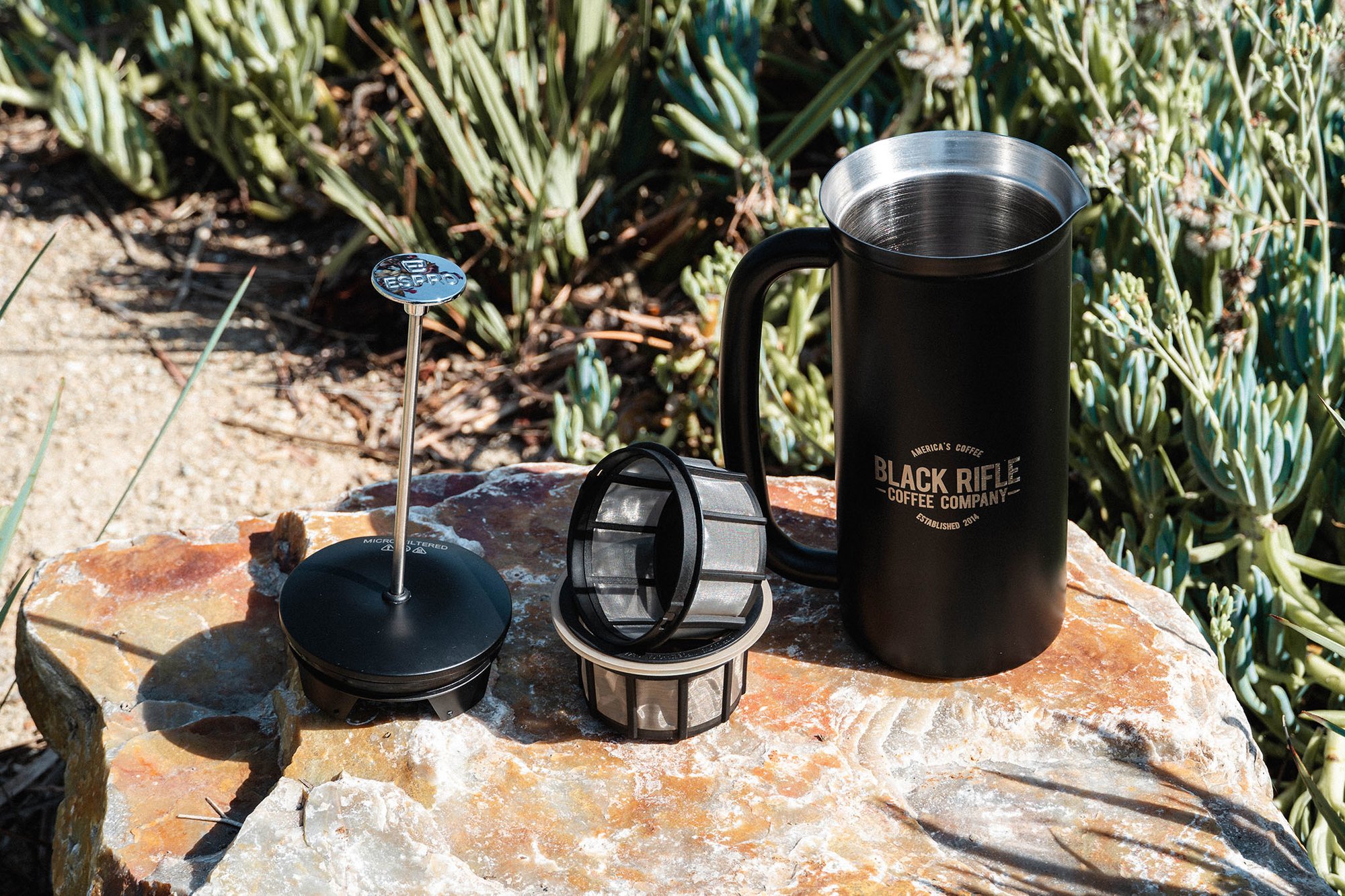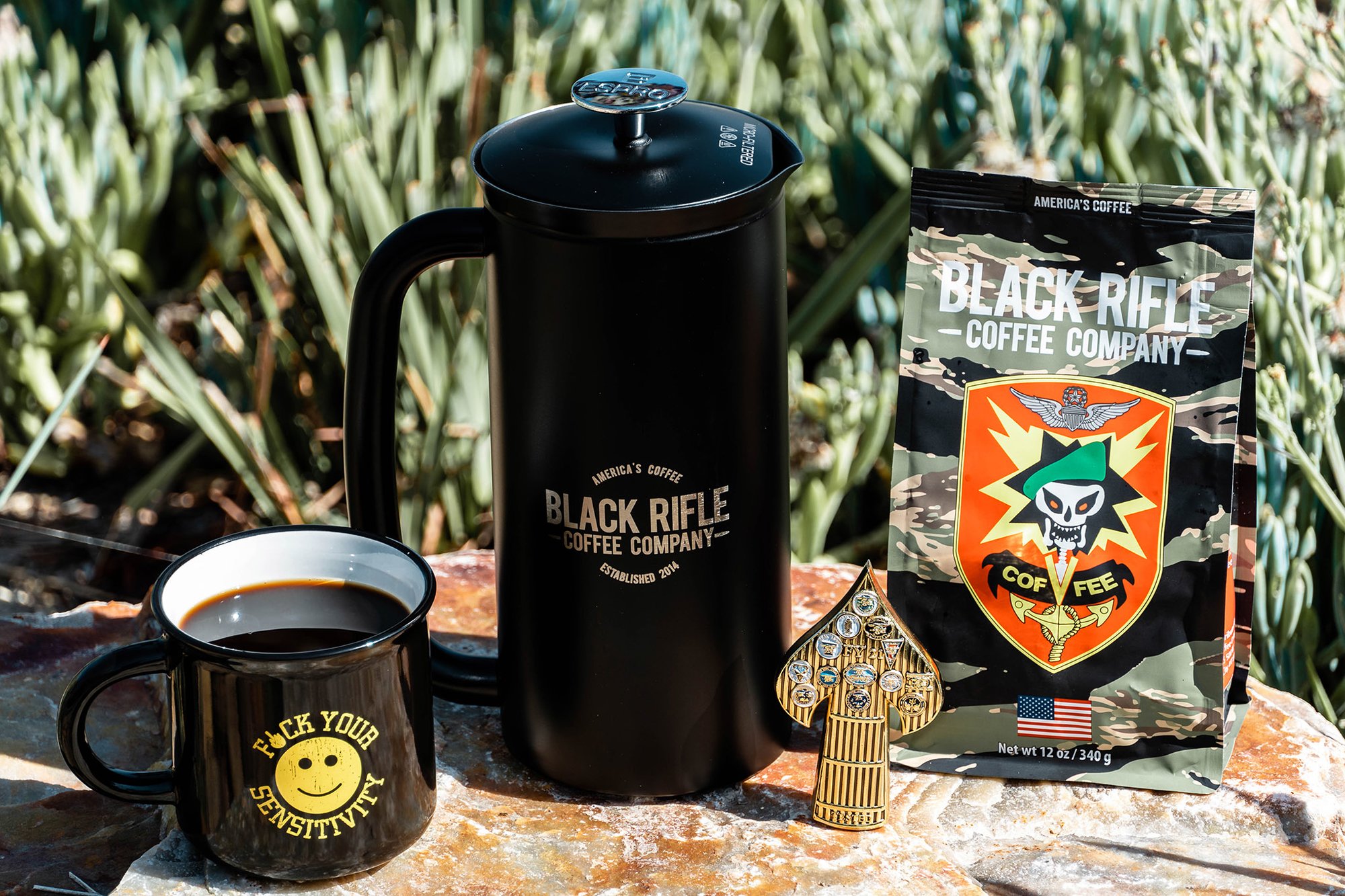The Espro P7 French Press Gives the BRCC MAC V Roast a Hot Extract

Photo courtesy of Black Rifle Coffee Company.
If you are a coffee enthusiast ready to dial in a particular brewing technique, getting intimately familiar with all aspects of the device you are using is a critical factor in fine-tuning your coffee craft.
While most Americans have heard the phrase “time is money,” when it comes to perfecting your personal barista skills at home, setting aside an adequate amount of time for each brew session can mean the difference between an average cup of joe and a great one.
This leads us to the French press. The history of this brewing device might not be very familiar to coffee drinkers here in the United States. Still, a study published in November 2020 revealed that approximately 4% of coffee drinkers in the US used a French press or plunger-type system in their daily coffee routines.
Though the device’s name credits the French, the Italians had a hand in inventing the French press brewing method as well. According to James Hoffmann’s book The World Atlas of Coffee: From Beans to Brewing, the French press was first documented in 1852. But it was not until 1929 that Attilio Calimani registered the first patents in Italy.

Unlike a typical pour over or drip coffee brewing system where the water passes through the coffee grounds, the French press is an infusion brewer. The water and coffee steep together in the brewing system, which helps produce a more uniform extraction.
The easy to use, reliable device can produce multiple cups of specialty quality coffee in only four minutes. And after a few trial runs, we were able to create consistent cups of specialty coffee and identify the flavor profiles of a given roast.
To learn the art of the French press, we used the Espro P7, which features a patented double micro-filter that keeps grit and sludge out of your cup and requires less cleanup than a traditional press does.
The P7 is constructed of double-walled stainless steel that can keep your coffee hot for hours. Many French press users recommend pouring all your desired cups immediately after your brew session to prevent overextraction, which creates a bitter taste. But the Espro P7’s mesh-filter holes are so small that they aid in preventing further extraction, allowing the user to keep a second or even third cup of coffee at the ready for extended periods.

When you press the plunger, the coffee is forced through two layers of mesh filter, which removes all but the very finest ground particles.
We ordered the P7 and the MAC V roast from Black Rifle Coffee Company. The MAC V roast was originally introduced through the Exclusive Coffee Subscription to honor the heroes who served with the Military Assistance Command, Vietnam — Studies and Observations Group (MACV-SOG).
Activated in 1964, the special operations unit played a pivotal role throughout the Vietnam War and carried out some of the most harrowing missions of the conflict.
For the return of MAC V, the BRCC roasting team sought a premium Vietnam Arabica that truly lived up to the MAC V name. Although Vietnam is the second-largest coffee producer globally, the BRCC team worked hard to deliver something unique, and it eventually landed on a 100% Lotus, a washed coffee that stood out from everything else. The new MAC V is a high-quality medium roast with delicious apricot, vanilla, and toffee notes.
One of the benefits of brewing with the Espro lineup of French presses is that there’s no need to grind as coarsely as you would for a conventional press pot. We had mistakenly ordered ground coffee instead of whole bean, which actually made it the perfect grind size for this technique.
We started with a 1-to-15 ratio of coffee to water for our first batch: for every gram of coffee, 15 grams of water. After that, it was all about making a few adjustments to our brewing technique, and we were off and running.

We used the larger 32-ounce P7, with a goal to make approximately two cups of coffee with each brew session. The P7 comes standard with convenient minimum- and maximum-fill lines inside the kettle, eliminating the need to measure your desired amount of water. Because we were only making two cups, we filled the kettle to the recommended minimum line each time.
Brewing With the Espro P7 French Press
- Fill the bottom of the 32-ounce Espro P7 with hot water to preheat the vessel.
- Twist to lock both micro-filters together, and screw them onto the plunger rod.
- Grind coffee just before use. A coarse grind gives the best results.
- Grind 24-36 grams of coffee. (We found 35 grams ideal.)
- Pour the water out of the kettle.
- Pour the ground coffee into the bottom of the vessel.
- Boil your water. Let it cool for a minute or two. The ideal temperature is 197-207 degrees Fahrenheit.
- Fill the P7 with hot water until the water and coffee meet the minimum fill line.
- Give it a quick stir to ensure all the grounds are wet.
- Put the lid on gently without pressing down on the plunger.
- Wait four minutes.
- Slowly press the filter plunger down to the bottom. Aim for the full press to take about 15 seconds.
- Pour the coffee and enjoy it in your favorite mug.
It took a couple of minor adjustments to fully enjoy the MAC V roast’s flavor profile. Our water temperature was initially right around 212 degrees Fahrenheit, or boiling point, which was way too hot for this brewing technique. That left the coffee overextracted and bitter tasting.
Pouring boiling water directly onto the ground coffee risks agitating the grounds unnecessarily, but this isn’t a big issue for the P7 because of its double-filtration system. However, if you use a single-filtration French press, this may result in some unwanted coffee grounds in your cup.
Cleanup was quick and easy. You simply remove the P7 lid, filters, and rod. Twist to unlock the dual filter. Hand-washing was a breeze, but we did notice a bit of excess coffee (about 1/4 cup) was always left inside the vessel when we disposed of the grounds.
The Espro P7 French press is a well-made brewing device that exceeded our expectations. Thanks to its dual micro-filter system, it delivered a clean cup of coffee, rivaling many paper filtration systems.
Read Next:

Kelly Getzelman is a former staff writer for Coffee or Die Magazine. A retired Navy SEAL chief petty officer, Getzelman has nearly two decades of special operations experience and is always ready to ship out on his next epic coffee adventure.
BRCC and Bad Moon Print Press team up for an exclusive, limited-edition T-shirt design!
BRCC partners with Team Room Design for an exclusive T-shirt release!
Thirty Seconds Out has partnered with BRCC for an exclusive shirt design invoking the God of Winter.
Lucas O'Hara of Grizzly Forge has teamed up with BRCC for a badass, exclusive Shirt Club T-shirt design featuring his most popular knife and tiomahawk.
Coffee or Die sits down with one of the graphic designers behind Black Rifle Coffee's signature look and vibe.
Biden will award the Medal of Honor to a Vietnam War Army helicopter pilot who risked his life to save a reconnaissance team from almost certain death.
Ever wonder how much Jack Mandaville would f*ck sh*t up if he went back in time? The American Revolution didn't even see him coming.
A nearly 200-year-old West Point time capsule that at first appeared to yield little more than dust contains hidden treasure, the US Military Academy said.












